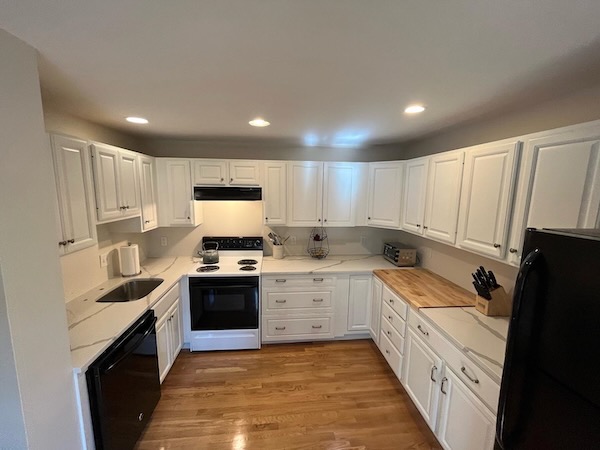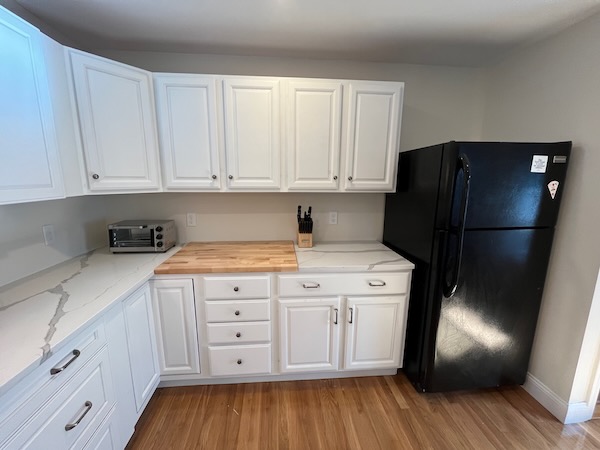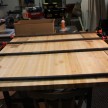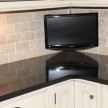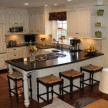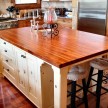How To Install Butcher Block Counters
Installing Butcher Block Countertop | PRO Tips
In this article, I’m going to show you the best way to fit a section of butcher block between two pieces of granite counter. The technique and steps I used are the same for fitting a stand-alone, butcher block counter.
Butcher Block Counter Install | Create a Template
A Butcher block is created from straight pieces of wood glued together into thick slabs. This creates a particularly strong work surface that’s ideal for cutting blocks and boards. There are many varieties of butcher blocks, and I purchased a Birch counter at Home Depot. Maple is what most people think of when they consider butcher block.

As a carpenter, I was taught and learned the hard way that story poles and templates make for an easier installation when fitting parts into spaces. In this situation, a template is MORE accurate than a tape measure. One simple way to make a template is to use luan plywood strips.
Butcher block for countertops usually comes in a 25-inch depth. This covers a standard 24-inch-deep cabinet with room for an overhang and enough excess width to fill gaps along the wall.
 Lay out the strips to form the perimeter of the butcher block countertop. Be sure to keep the strips tight to the sides of the counter and back wall and remember to include your overhang. In my situation, I was matching an existing granite overhang.
Lay out the strips to form the perimeter of the butcher block countertop. Be sure to keep the strips tight to the sides of the counter and back wall and remember to include your overhang. In my situation, I was matching an existing granite overhang.

Connect the strips with hot glue. Once the glue is dry, I place a few short screws into the strips for reinforcement. I use a pencil to mark the strips and a marker to mark the front, back, and sides of the template so I don’t get confused back at the saw.

My opening was NOT square and if I had not used a template, it most likely would not be a good fit.
Pro Tip:
- If a back wall has a curve or bow, I will scribe and cut the back template board first to fit and conform to the shape of that area, then make my 4-sided template.
Butcher Block Counter | Cutting to Size
Like a lot of wood species today, Butcher block has two faces. Side A, the countertop side, is the better side, and side B shows more knots. Make sure you look at the faces, line up your front edge to the template and trace your template on that best face.
I placed my template on the butcher block counter, clamped it in place, and traced my template lines to the block.
I used a track saw to cut the sides of the butcher block at 90 degrees and on the back edge, I cut a 5 or 10-degree back bevel. I then dry-fit the butcher block to the granite counter opening and adjust until I am satisfied with the fit.
Pro Tips:
- A back bevel allows me to easily fine-tune the back wall fitted with a hand plane if needed. The back bevel creates a sharp tip that touches the wall at the top edge. When planning for a tighter fit I only must place that sharp edge.
- As a finish carpenter I want miters, and trim tight. It’s important to note that when butcher block countertops are installed next to any hard surface, like granite, you should leave a little room for the expansion and contraction of the wood. I left 1/32” on both sides and hope that’s enough.
Easing the Edges
The butcher block measures 1-1/2” and the granite is 1-1/4” so I needed to round over the butcher block edges as they would be higher and exposed.
I used a 3/8” radius bit and ball bearing and my router to round over the front and two sides of the butcher block counter
Sanding the Butcher Block
Typically, the butcher block comes prefinished to 120-grit sanding. I sanded the top and 3-edges evenly with 100-150 grit sandpaper and a random orbital sander to remove any scratches and mill marks from the router bit, that may only be seen after applying a finish.
One trick to see mill marks is to wipe the wood with a rag and denatured alcohol. This will often show mill marks and will raise the grain on the wood.

Pro Tips:
- Resist the temptation to sand to a higher grit as this will prevent the sealer from absorbing. Also, lightly sand the bottom face of the butcher block to etch the wood for better absorption of the finish. All 6-sides of the butcher block counter within 48 hours to prevent it from absorbing moisture and moving.
- This is also the stage where you can address any defects or voids in the wood and fill it with either epoxy or CA glue.
Apply Food Grade Finish
Remember you must seal all six sides and edges on a wood countertop to prevent cupping from seasonal humidity absorption. Use a food-safe, finish. Most finishes are tung oil with additives, that are food safe after the oil has completely cured.

I used Watco Butcher Block Oil & Finish. I like the WATCO brand because it is easy to use and is a food-safe finish. WATCO requires 6 hours and 400 grit etching between additional coats and 72 hours of curing before use.

I brushed on the finish for even coating and wiped it off with a rag. I wanted to have a quick coat on the top prior to my installing it. I intend to let this coat dry for 48 hours and apply at least 2 to 4 more coats.
Fastening the Butcher Block Counter
To prepare for my installation I started by drilling ⅝ inch holes in each of the four corners braces of the cabinet. If possible, and in a perfect application, you will want to fasten your countertop every 24 to 30 inches back and front. Too many fasteners can keep the butcher block from moving properly. Typically, a fastener at each cabinet corner brace is sufficient.
 After drilling, I removed some drawers and a few drawer slides for better access and installed the butcher block countertop in the space. I then drilled ⅛ inch pilot holes through the larger hole I just drilled and into the butcher block. I set my drill bit to drill ¾ to 1” penetration into the 1-1/2” thick butcher block. I know this is obvious but it’s worth mentioning, pay attention here, do not drill all the way through the countertop! When drilling the pilot hole, be sure to center it within the larger 5/8” holes.
After drilling, I removed some drawers and a few drawer slides for better access and installed the butcher block countertop in the space. I then drilled ⅛ inch pilot holes through the larger hole I just drilled and into the butcher block. I set my drill bit to drill ¾ to 1” penetration into the 1-1/2” thick butcher block. I know this is obvious but it’s worth mentioning, pay attention here, do not drill all the way through the countertop! When drilling the pilot hole, be sure to center it within the larger 5/8” holes.

To secure the countertop down to the cabinet use 1½ inches diameter fender washers and a pan head screw that will penetrate at least one-half of the thickness of your top. The oversized ⅝ inch holes and the fender washer/Panhead screw assembly allow the screw to move as the butcher block countertop expands and contracts with the seasonal changes in temperature and humidity.

Pro Tips:
- Do not glue or silicone your top down to prevent expansion and contraction that can cause warping or cracks.
- Do not install your butcher block countertop directly on a solid surface such as plywood, as this prevents the underside from breathing.

Future Maintenance
The Butcher block should be recoated or oiled whenever the wood starts to look dry and chalky. To clean the butcher block use soap and water. To disinfect using disinfecting wipes designed to kill 99.9% of viruses and bacteria.
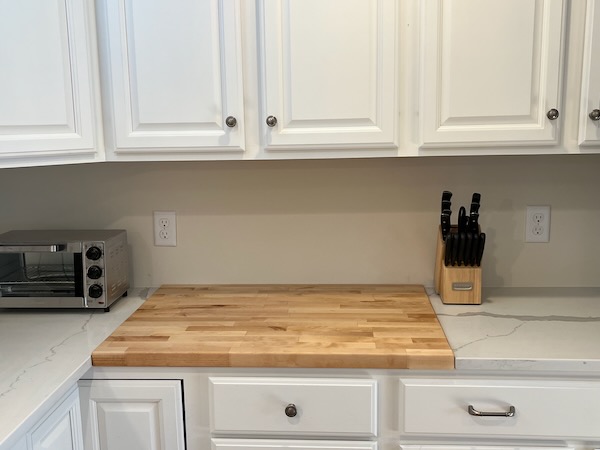
Butcher block is an affordable material and if you have a smaller budget, then butcher block can be a nice option that doesn’t break the bank.
